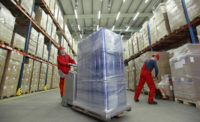Report: Smart packaging offers exciting opportunities in online grocery sector
Packaging will play an important role in response to the trends that are shaping the growth of online grocery, says the report.

Smart packaging technologies based on unique digital codes will take both online and offline grocery in new directions during the next few years, according to the Tetra Pak Index 2018, released by Tetra Pak, Vernon Hills, Ill.
Packaging will play an important role in response to the trends that are shaping the growth of online grocery, says the report.
Trends shaping the growth of online grocery
The Tetra Pak Index 2018 highlights four key trends shaping the growth of online grocery:
- Convenience. Convenience is the main driver for online consumer take-up, as time-crunched consumers look for new ways to make their life easier. Key opportunities include easy product replenishment and voice and convenient packaging.
- Sustainability. Pressure on plastic and awareness of the circular economy will continue to grow, and recycling will become ever more important. Consumers want to know if brands are “doing the right thing.”
- Personalization and uniqueness. Customization of products and personalization in the consumer journey will be important differentiators going forward. This is accelerating the direct-to-consumer trend, and as many as 80% of consumer packaged goods companies are predicted to migrate to this model by 2025.
- Technology and performance. Super-fast delivery in as little as 10 minutes is expected by 2025, changing consumer behavior to buy more frequently and in smaller amounts, adding more complexity to the logistics. Supply chains will continue to be transformed by a raft of technologies, notably radio-frequency identification (RFID) and robotics, boosting efficiency and transparency.
The role of smart packaging
Smart packaging technologies based on unique digital codes allow each and every product package to be given a unique identifier. These codes can be read by either data scanning devices or an ordinary smartphone.
It creates an interactive channel with individual consumers, allowing brands to have a real-time conversation with the consumer, sharing details on the sourcing of raw materials, nutritional facts, as well as games, promotions and environmental information.
At the same time, with insights captured through these digital codes, brands can continuously improve the shopping experience and make it ever more personalized for the consumer.
e-retailers are also calling for unique identifiers compatible with the robotic technology used in their warehouse and distribution. Data and full traceability helps operators navigate complex logistics and improve efficiency, moving closer to real-time order fulfilment.
“The rise of online grocery is a great opportunity for food and beverage brands, and packaging plays a key role in supporting their success,” says Alexandre Carvalho, director global marketing services. “In particular, smart packaging helps drive greater transparency and efficiency in the supply chain, up and down stream, while also enabling a direct, interactive relationship with the consumer. We believe this rapidly developing technology, tried and tested by us since 2016, and now being deployed in Europe, can help our customers explore new avenues, driving growth in the years ahead.”
Tetra Pak Index 2018 is based on consumer research conducted in the United States, UK, China, Saudi Arabia and Korea, a global market segmentation study, as well as interviews with e-retailers in the United States, Europe and China.
Looking for a reprint of this article?
From high-res PDFs to custom plaques, order your copy today!





